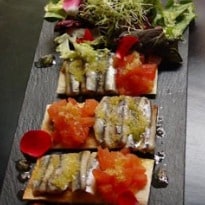Do you still dance to the rhythm of starter, main course and dessert, or favour a more free-form tapas-type meal?
A slow revolution is taking place in restaurant dining rooms: the three-course menu is on a steady decline into obscurity. In an age of tasting menus and restaurants that take cues from the informal serving styles of Spanish and Asian cuisine, the tripartition of a meal seems increasingly archaic and coercive. These days, when I'm presented with a menu that invites me to pick a starter, main and dessert, I often end up choosing three dishes from the starter section, sometimes to the chagrin of fellow diners who find this approach an affront to the rules of the game.
I don't do this out of spite or for reasons of austerity, but rather because I find the main course an unnecessary burden. The most quirky and inventive bits of a menu are almost always to be found among the starters, while mains feel like little more than bulky obstacles.
At the top end, the three-course meal hasn't been in vogue for some time. Many chefs have ditched traditional menus in favour of multi-course servings of small plates (with all the pitfalls that may occur when chefs have free rein). But it's not just in the upper echelons of gastronomy that a different approach is becoming more common. Whether it's the remixing of Asian cuisine in the US or Venetian-style tapas dining in London, menus now tend to ditch the traditional categorisation of dishes and instead offer diners more freedom to dictate the rhythm of their meal.Somewhere in the middle is the menu at St. John Bread & Wine, where the dishes are organised by time stamps which reflect the flow of the day and of the kitchen. The prices and girth of the dishes increase as you move down the menu, but its structure allows for more improvisation and encourages the sharing of plates. And although they wouldn't dare send out a plate of pig's head before oysters, the food often arrives at the table in a free-flowing manner.
"It a more relaxed approach and the diners are more relaxed," says Bread & Wine head chef Lee Tiernan. "When you go to a Chinese or a Vietnamese restaurant most of the time they just start bringing out dishes to the table, and I think that's a great way to eat. That's the way I like to eat and I just happen to work in a restaurant that promotes that way of eating."
Paul Rozin, a psychology professor at the University of Pennsylvania, has studied the way we like to eat and the link between the structure of a meal and our memories of it. At this summer's MAD symposium in Copenhagen, a gathering of chefs and culinary minds organised by the restaurant Noma, he challenged the audience to look at meals in the context of classical music. Symphonies will start and end with the most dynamic and memorable elements, but even the most progressive chefs still seem to want to finish with dessert. He then conducted a spontaneous survey to find out which of the three courses of a traditional meal people most looked forward to: appetiser, main or dessert. An overwhelming majority voted for the appetiser.
Rozin says that when he goes to a regular restaurant he will typically pick an extra appetiser or two instead of a main course. I couldn't agree more, but would you choose the same way, or do you still prefer the traditional three-course meal?
Tapas at Ole Lola, Madrid. Photograph: PR










